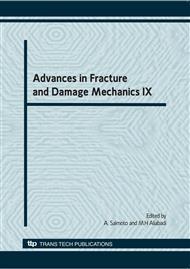p.553
p.557
p.561
p.565
p.569
p.573
p.577
p.581
p.585
Towards a Model for Fresh Granular-Paste Systems Based on Discrete Element Method
Abstract:
Modelling the rheological behaviour of fresh granular-paste systems is the main aim of this study. The research approach is based on a conceptual idea where the paste-interaction system is explicitly modelled by an interactive two phase particle system. As a first approach the cohesive force-displacement interaction was measured for two ideally shaped glass particles bridged by water. Later on, the water was replaced by cement paste and the attraction force acting on the glass particles was measured for increasing inter-particle distances. The results gave a very good impression of the cohesive forces acting on a granular paste system employed by the cementations material in its fresh state. The Discrete Element Method (DEM) is one of the computational techniques that is applied to simulate the granular-paste system. With this method, the fresh granular-paste system is divided into two phases (aggregate/paste) and is modelled by a single-phase or a double-phase system of DEM elements. At the first step, the interaction forces of the particle-paste system are compared with the experimental results achieved from the particle-liquid measurements and expressed as an explicit function based on local geometrical and physical parameters. Modelling and experimental results show good agreement.
Info:
Periodical:
Pages:
569-572
Citation:
Online since:
November 2010
Authors:
Price:
Сopyright:
© 2011 Trans Tech Publications Ltd. All Rights Reserved
Share:
Citation:


